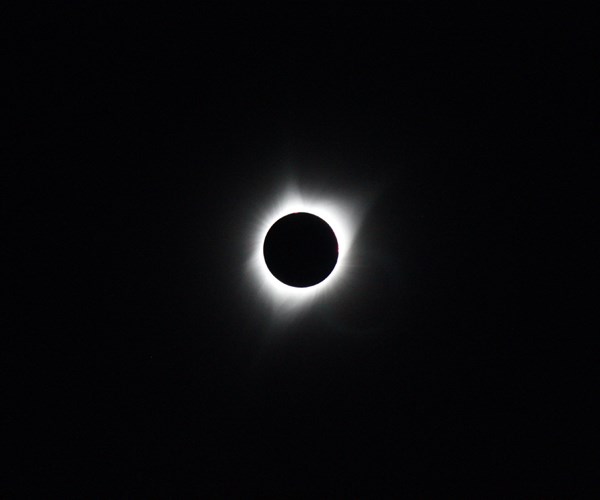A total eclipse of the sun
The humbling, startling, dusky, stunning unreality of a total eclipse of the sun.

August 21 solar eclipse, Imogene Lake, Idaho. (Source: Thomas Sloan)
My oldest son, Thomas, suggested in late July that he was thinking about backpacking into the Sawtooth Wilderness in southern Idaho the weekend before Aug. 21 to bear witness to the totality of a solar eclipse, which was to occur at 11:30 am on that day. He invited a couple of friends to go with him, but they were not available. So, he invited me.
We brought with us Leo, our 1-year-old Golden Retriever, drove 13 hours, arrived at the trailhead on Sunday, Aug. 20 and hiked about 5 miles in to Hell Roaring Lake, where we pitched our tents for the night. The next morning, Aug. 21, at 8:30 am, we hiked another 4 miles to Imogene Lake, and at 10:30 am found a spot along the east side of the lake that offered a great view of the water, mountains and sun, which had, not long before we arrived, cleared the peaks behind us. There were other people there, on the other side of the lake, in small groups, sitting on rocks and outcroppings.
Using our welding glass, we monitored the progress of the moon as it crept slowly in front of the sun, while Leo cooled off in the lake. We were struck, throughout this process, how persistent the sun’s energy and intensity was. Even as the eclipse exceeded 50% totality, there was little discernable difference in the light we could see and feel about us. And it was not until the eclipse reached about 90% totality that we noticed the temperature starting to drop and the color about us in the water, trees and mountains beginning to drain. And then, suddenly, the bees and flies that had found us so interesting all morning, simply vanished. Leo removed himself from the lake and sat next to us on the shore.
Totality struck quickly, as if a veil had been gently draped over the sky, and we were plunged not into total darkness, but a surreal dusk. Jupiter emerged directly overhead. Someone across the lake bellowed in approval. We put down the welding glass and, for the first time, looked at the eclipse with naked eyes. The moon was a solid black disk surrounded by solar prominences protruding in white, gauzy filaments. For 2 minutes it persisted and we consumed, as much as we could, the world around us.
A total eclipse is visually stunning for all of the obvious reasons: The sun is almost perfectly blotted out, day becomes dusk, planets snap into view, the whole world feels closer and smaller. But a total eclipse is remarkable for another reason as well: It offers a complete and thorough disruption of the light cycle rhythm that marks our daily existence. It inserts night when we know it is day. It alters a force of nature that is unalterable. It quietly and gradually suspends our daily reality with with unreality. The world paused, and we paused with it.
And then, just as quickly, it was over. Bright yellow light reanimated itself. Color re-saturated trees, rocks, water. Bees and flies returned, regrettably. Leo jumped back in the water. Thomas and I sat for another 45 minutes and absorbed this gradual restarting of the world and talked about all that we’d seen and felt. Then, we packed up, coaxed Leo of out the water and began our trek back down the mountain.
The next total eclipse in the US is in 2024. Perhaps I will see you there.

Leo, post-eclipse.
Related Content
Welding is not bonding
Discussion of the issues in our understanding of thermoplastic composite welded structures and certification of the latest materials and welding technologies for future airframes.
Read MoreDevelopment of a composite liquid hydrogen tank for commercial aircraft
Netherlands consortium advances cryogenic composites testing, tank designs and manufacturing including AFP, hybrid winding, welding of tank components and integrated SHM and H2 sensors for demonstrators in 2025.
Read MorePlant tour: Airbus, Illescas, Spain
Airbus’ Illescas facility, featuring highly automated composites processes for the A350 lower wing cover and one-piece Section 19 fuselage barrels, works toward production ramp-ups and next-generation aircraft.
Read MoreThe next-generation single-aisle: Implications for the composites industry
While the world continues to wait for new single-aisle program announcements from Airbus and Boeing, it’s clear composites will play a role in their fabrication. But in what ways, and what capacity?
Read MoreRead Next
Ultrasonic welding for in-space manufacturing of CFRTP
Agile Ultrasonics and NASA trial robotic-compatible carbon fiber-reinforced thermoplastic ultrasonic welding technology for space structures.
Read MoreNext-gen fan blades: Hybrid twin RTM, printed sensors, laser shock disassembly
MORPHO project demonstrates blade with 20% faster RTM cure cycle, uses AI-based monitoring for improved maintenance/life cycle management and proves laser shock disassembly for recycling.
Read MoreCeramic matrix composites: Faster, cheaper, higher temperature
New players proliferate, increasing CMC materials and manufacturing capacity, novel processes and automation to meet demand for higher part volumes and performance.
Read More





















